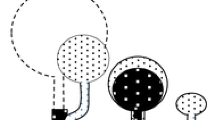Abstract
Various means of vegetative reproduction in unexploited forests in western Europe are illustrated with examples. Root suckers are sometimes almost the only method of forest regeneration near the limits of tree growth on the Wadden islands and they can play an important role in forest gaps and riverine forests. Trunk suckers finally replacing their parent trees occur in Alnus, Tilia and Ulmus. Partial uprooting of trees, favoured by special soil conditions, was shown to be an important condition for vegetative reproduction. Temporary survival after uprooting gives opportunity for development of reiterative sprouts, that can replace the vertical axis of a fallen tree. Contact of living branches or even whole stems with soil or mouldering logs favours the growth of adventitious roots. Thus vegetatively reproduced individual trees establish before the uprooted parent tree finally dies. Examples of the clonal spreading of trees are given and a special strategy of layering its branches in pasture woods has been described for beech. Modern forestry rigorously eliminates conditions suitable for the vegetative reproduction of forest trees so their abilities in this respect are often underestimated. Vegetative reproduction seems to be particularly important under circumstances where natural growth is difficult e.g. near the limits of tree growth, on dynamic sites and under heavy shade.
Similar content being viewed by others
References
Burrichter E., Pott R., Raus T. & Wittig R., 1980. Die Hudelandschaft ‘Borkener Paradies’ im Emstal bei Meppen. Abh. Landesmus. Naturk., Münster Westfalen. 42(4): 1–65.
Caldwall P. A., 1957. The spatial development of Spartina colonies growing without competition. Ann. Bot. N.S. 21: 203–216.
Edlin H. L., 1977. The natural history of trees. Weidenfeld Nicolson, London.
Falinski J. B., 1986. Vegetation dynamics in temperate lowland primeval forests. Junk, Dordrecht.
Fanta J., 1981. Fagus sylvatica L. und das Aceri-Fagetum an der alpinen Waldgrenze in Mitteleuropaïschen Gebirgen. Vegetatio 44: 13–24.
Grasveld, P. & Imming, J., 1987. Natuurlijke ontwikkelingen op Drentse stormvlaktes. Report Research Institute for Nature Management, Leersum.
Hallé F., Oldeman R. A. A. & Tomlinson P. B., 1978. Tropical trees and forests in architectural analyses. Springer, Berlin-Heidelberg-New York.
Heybroek H. M., 1984. Clones in forestry and nature. Arboricult. J. 8: 275–286.
Kalela, E. K., 1961. Metstät ja Mesien hoito. Porvoo-Helsinki.
Koop H., 1981. Vegetatiestructuur en dynamiek van twee 094 natuurlijke bossen: Het Neuenburger en Hasbrucher Urwald. Versl. Landbouwk. Onderz. 904. Pudoc Wageningen.
Korpel S. & Dorcik A., 1973. Die Reservation ‘Jursky Súr’ und ihre forstwissenschaftliche Bedeutung. Ceskoslov. Ochr. Prir. 16: 303–323.
Mayer H., 1984. Wälder Europas. Fischer, Stuttgart-New York. 094
Mitchell A., 1974. A field guide to the trees of Britain and northern Europe. Collins, London.
Moerenhout, M. & Pass, M., 1987. Bostypen of Terschelling. Report Research Institute for Nature Management, Leersum.
Ovington J. D., 1965. Woodlands. English University Press, London.
Pott R., 1981. Der Einflusss der Niederholzwirtschaft auf die Physiognomie und die floristisch-soziologische Struktur von Kalkbuchenwälder. Tuexenia 1: 233–242.
Rackham O., 1976. Trees and woodland in the British landscape. Dent, London.
Rackham, O., 1980. Ancient woodlands, their plants life history and use. Arnolds.
Sprugel D. G., 1976. Dynamic structure of wave-regenerated Abies balsamea forests in the northeastern United States. J. Ecol. 64: 889–912.
Sprugel D. G. & Bormann E. F., 1981. Natural disturbance and steady state high-altitude balsam fir forests. Science 211: 390–393.
Vandeursen, J. & Wisse, J., 1985. De invloed van fluviatiele dynamiek op de groei en structuur van een natuurlijk Fraxino-Ulmetum in de Elzas. Report Research Institute for Nature Management, Leersum.
Walter, J. M. N., 1982. Architectural profiles of flood forests in Alsace. In: H. Dierschke (ed.), Struktur und Dynamik von Wäldern. Ber. Symp. Int. Verein. Vegetationsk. Rinteln.
Author information
Authors and Affiliations
Rights and permissions
About this article
Cite this article
Koop, H. Vegetative reproduction of trees in some European natural forests. Vegetatio 72, 103–110 (1987). https://doi.org/10.1007/BF00044840
Accepted:
Issue Date:
DOI: https://doi.org/10.1007/BF00044840




